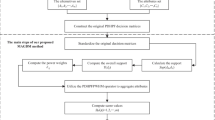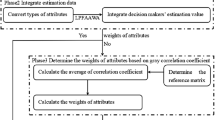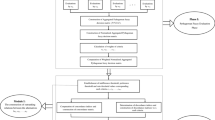Abstract
Pythagorean fuzzy sets have higher performance in expressing uncertainty information in multi-attribute group decision-making (MAGDM). The linear programming technique for multidimensional analysis of preference (LINMAP) is a prototypical compromising model that adjusts the deviation between objective assessments and subjective preferences on decision alternatives. However, the disadvantages of Pythagorean fuzzy sets in conflict measure and LINMAP model in inconsistent decision information structure have not been solved yet. To solve the problems that incomplete decision information in Pythagorean fuzzy set and inconsistent evaluation structure in LINMAP, the spatial measures and Dempster-Shafer evidence theory are introduced. A new spatial structure conflict measure is thus presented, and the belief structure of Dempster-Shafer evidence theory is used to provide a unified decision-making framework for LINMAP inconsistent evaluation structure. Firstly, a novel spatial distance measurement method is developed. Secondly, comprehensive closeness is introduced to measure individual order consistency and inconsistency between subjective preference and objective evaluation. Thirdly, we define the objective basic probability assignment and subjective basic probability assignment based on Dempster-Shafer belief structure to develop the bi-objective LINMAP of Pythagorean fuzzy sets and add the deviance between individual goodness of fit and poorness of fit is introduced as constraints to obtain the optimal attribution weights. Then, the final order of decision alternatives can be obtained by the fusion rules of Dempster-Shafer. Finally, we verify that the proposed method can improve the alternative discrimination in the case of unstable order, and the result of alternative order total biased of the proposed method is reduced by at least 80% compared with the comparative method.









Similar content being viewed by others
Explore related subjects
Discover the latest articles, news and stories from top researchers in related subjects.Data availability
Data openly available in a public repository.
References
Zahid, K., Akram, M., Kahraman, C.: A new ELECTRE-based method for group decision-making with complex spherical fuzzy information. Knowl Based Syst. 243, 108525 (2022)
Ming, T., Liao, H.C.: From conventional group decision making to large-scale group decision making: what are the challenges and how to meet them in big data era? A state-of-the-art survey. Omega 100, 102141 (2021)
Yager, R.R., Abbasov, A.M.: Pythagorean membership grades, complex numbers, and decision making. Int. J. Intell. Syst. 28(5), 436–452 (2013)
Hendiani, S., Lev, B., Gharehbaghi, A.: Diagnosing social failures in sustainable supply chains using a modified pythagorean fuzzy distance to ideal solution. Comput. Ind. Eng. 154, 107156 (2021)
Dempster, A.P.: Upper and lower probabilities induced by a multivalued mapping. Ann. Math. Stat. 38, 325–339 (1967)
Dymova, L., Krzysztof, K., Pavel, S.: An extension of rule base evidential reasoning in the interval-valued intuitionistic fuzzy setting applied to the type 2 diabetes diagnostic. Expert Syst. Appl. 201, 117100 (2022)
Yang, L.H., Liu, J., Ye, F.F., Wang, Y.M., Nugent, C., Wang, H., Martínez, L.: Highly explainable cumulative belief rule-based system with effective rule-base modeling and inference scheme. Knowl Based Syst. 240, 107805 (2022)
Dag, A.Z., Akcam, Z., Kibis, E., Simsek, S., Delen, D.: A probabilistic data analytics methodology based on Bayesian belief network for predicting and understanding breast cancer survival. Knowl Based Syst. 242, 108407 (2022)
Krishankumaar, R., Mishra, A.R., Gou, X., Ravichandran, K.S.: New ranking model with evidence theory under probabilistic hesitant fuzzy context and unknown weights. Neural Comput. Appl. 34, 1–15 (2022)
Petturiti, D., Vantaggi, B.: Conditional decisions under objective and subjective ambiguity in Dempster-Shafer theory. Fuzzy Sets Syst. (2022). https://doi.org/10.1016/j.fss.2022.02.011
Zhang, Y.X., Hao, Z.N., Xu, Z.S., Zeng, X.J., Xu, X.X.: A process-oriented probabilistic linguistic decision-making model with unknown attribute weights. Knowl-Based Syst. 235, 107594 (2022)
Rong, L.L., Wang, L., Liu, P.D.: Supermarket fresh food suppliers evaluation and selection with multigranularity unbalanced hesitant fuzzy linguistic information based on prospect theory and evidential theory. Int. J. Intell. Syst. 37(3), 1931–1971 (2022)
Liu, P.D., Zhang, X.H.: A new hesitant fuzzy linguistic approach for multiple attribute decision making based on Dempster-Shafer evidence theory. Appl. Soft Comput. 86, 105897 (2020)
Li, X.H., Chen, X.H.: Belief structure-based induced aggregation operators in decision making with hesitant fuzzy information. Neural Comput Appl. 31(12), 8917–8929 (2019)
Fei, L.G., Feng, Y.Q., Wang, H.L.: Modeling heterogeneous multi-attribute emergency decision-making with dempster-shafer theory. Comput. Ind. Eng. 161, 107633 (2021)
Chen, T.Y.: Pythagorean fuzzy linear programming technique for multidimensional analysis of preference using a squared-distance-based approach for multiple criteria decision analysis. Expert Syst. Appl. 164, 113908 (2021)
Pereiraa, M.A., Camanhoc, A.S., Figueiraa, J.R., Marques, R.C.: Incorporating preference information in a range directional composite indicator: the case of Portuguese public hospitals. Eur. J. Oper. Res. 294(2), 633–650 (2021)
Srinivasan, V., Shocker, A.D.: Linear programming techniques for multi-dimensional analysis of preferences. Psychometrika 38(3), 337–369 (1973)
Haghighi, M.H., Mousavi, S.M., Mohagheghi, V.: A new soft computing model based on linear assignment and linear programming technique for multidimensional analysis of preference with interval type-2 fuzzy sets. Appl. Soft Comput. 77, 780–796 (2019)
Wu, Z., Xu, J.: Managing consistency and consensus in group decision making with hesitant fuzzy linguistic preference relations. Omega 65, 28–40 (2016)
Ju, D.: Hesitant fuzzy 2-dimension linguistic programming technique for multidimensional analysis of preference for multicriteria group decision making. Mathematics. 9(24), 3196 (2021)
Liu, A.H., Wan, S.P., Dong, J.Y.: An axiomatic design-based mathematical programming method for heterogeneous multi-criteria group decision making with linguistic fuzzy truth degrees. Inform. Sci. 571, 649–675 (2021)
Dong, J.Y., Wan, S.P., Chen, S.M.: Fuzzy best-worst method based on triangular fuzzy numbers for multi-criteria decision-making. Inform. Sci. 547, 1080–1104 (2021)
Yang, Y.J., Francisco, C.: Consistency of 2D and 3D distances of intuitionistic fuzzy sets. Expert Syst. Appl. 39(10), 8665–8670 (2012)
Wan, S.P., Jin, Z., Dong, J.Y.: Pythagorean fuzzy mathematical programming method for multi-attribute group decision making with Pythagorean fuzzy truth degrees. Knowl. Inf. Syst. 55(2), 437–466 (2018)
Li, D., Zeng, W.: Distance measure of pythagorean fuzzy sets. Int. J. Intell. Syst. 33(2), 348–361 (2018)
Sadabadi, S.A., Hadi-Vencheh, A., Jamshidi, A., Jalali, M.: A linear programming technique to solve fuzzy multiple criteria decision making problems with an application. RAIRO-Oper. Res. 55(1), 83–97 (2021)
Wang, J.C., Chen, T.Y.: A novel pythagorean fuzzy LINMAP-based compromising approach for multiple criteria group decision-making with preference over alternatives. Int. J. Comput. Int. Sys. 13(1), 444–463 (2020)
Akram, M., Luqman, A., Alcantud, J.C.R.: An integrated ELECTRE-I approach for risk evaluation with hesitant Pythagorean fuzzy information [J]. Expert Syst. Appl. 200, 116945 (2022)
Talukdar, P., Dutta, P.: Distance measures for cubic Pythagorean fuzzy sets and its applications to multicriteria decision making[J]. Granular Comput. 6(2), 267–284 (2021)
Xue, W., Xu, Z., Zhang, X., et al.: Pythagorean fuzzy LINMAP method based on the entropy theory for railway project investment decision making [J]. Int. J. Intell. Syst. 33(1), 93–125 (2018)
Khan, M.J., Ali, M.I., Kumam, P.: Improved generalized dissimilarity measure based VIKOR method for Pythagorean fuzzy sets[J]. Int. J. Intell. Syst. 37(3), 1807–1845 (2022)
Zeng, W., Li, D., Yin, Q.: Distance and similarity measures of Pythagorean fuzzy sets and their applications to multiple criteria group decision making. Int. J. Intell. Syst. 33(11), 2236–2254 (2018)
Zhou, F., Chen, T.Y.: Multiple criteria group decision analysis using a Pythagorean fuzzy programming model for multidimensional analysis of preference based on novel distance measures [J]. Comput. Ind. Eng. 148, 106670 (2020)
Zhou, F., Chen, T.Y.: An integrated multicriteria group decision-making approach for green supplier selection under Pythagorean fuzzy scenarios [J]. Ieee Access. 8, 165216–165231 (2020)
Chen, T.Y.: Multiple criteria group decision making using a parametric linear programming technique for multidimensional analysis of preference under uncertainty of Pythagorean fuzziness [J]. IEEE Access. 7, 174108–174128 (2019)
Wang, Z., Ran, Y., Chen, T.Y., Yu, H., Zhang, G.: Failure mode and effects analysis using extended matter-element model and AHP. Comput. Ind. Eng. 140, 1–8 (2020)
Sarkar, B., Biswas, A.: A unified method for Pythagorean fuzzy multicriteria group decision-making using entropy measure, linear programming and extended technique for ordering preference by similarity to ideal solution. Soft. Comput. 24(7), 5333–5344 (2019)
Liao, N., Wei, G., Chen, X.: TODIM method based on cumulative prospect theory for multiple attributes group decision making under probabilistic hesitant fuzzy setting. Int. J. Fuzzy Syst. 24, 322–339 (2022). https://doi.org/10.1007/s40815-021-01138-2
Zhang, X.L., Xu, Z.S.: Extension of TOPSIS to multiple criteria decision making with Pythagorean fuzzy sets. Int. J. Intell. Syst. 29(12), 1061–1078 (2014)
Kahneman, D., Tversky, A.: Prospect theory: an analysis of decision under risk. Econometrica 47, 263–291 (1979)
Farhadinia, B.: Similarity-based multi-criteria decision making technique of pythagorean fuzzy sets. Artif. Intell. Rev. 2021, 1–46 (2021)
Xu, Z.S.: An overview of methods for determining OWA weights. Int. J. Intell. Syst. 20(8), 843–865 (2005)
Wang, Y., Chen, F., Zhuang, G., Yang, G.: Dynamic event-based mixed H∞ and dissipative asynchronous control for Markov jump singularly perturbed systems. Appl. Math. Comput. 386, 125443 (2020)
Wang, Y., Chen, F., Zhuang, G.: Dynamic event-based reliable dissipative asynchronous control for stochastic Markov jump systems with general conditional probabilities. Nonlinear Dynam. 101, 465–485 (2020)
Mehdi, D., Marzieh, A., Elnaz, E., Alessio, I.: A probabilistic hesitant fuzzy Choquet integral-based TODIM method for multi-attribute group decision-making. Expert Syst. Appl. 191, 116266 (2022)
Wang, Y.Q., Chen, F., Zhuang, G.M., Song, G.F.: Event-based asynchronous and resilient filtering for Markov jump singularly perturbed systems against deception attacks. ISA T. 112, 56–73 (2021)
Funding
This paper is supported by the National Natural Science Foundation of China (No. 71971117, No. 71671001) and the Ministry of education of Humanities and Social Science project of China (No. 17YJA630035).
Author information
Authors and Affiliations
Contributions
JW contributed to writing—original draft, validation, software, formal analysis writing—review & editing, and visualization. WJ contributed to conceptualization, methodology, supervision, writing—review & editing, and funding acquisition. XT contributed to writing—review & editing. BG contributed to writing—review & editing and funding acquisition.
Corresponding author
Ethics declarations
Conflict of interest
The authors declare that they have no known competing financial interests or personal relationships that could have appeared to influence the work reported in this paper.
Rights and permissions
Springer Nature or its licensor (e.g. a society or other partner) holds exclusive rights to this article under a publishing agreement with the author(s) or other rightsholder(s); author self-archiving of the accepted manuscript version of this article is solely governed by the terms of such publishing agreement and applicable law.
About this article
Cite this article
Wang, J., Jiang, W., Tao, X. et al. Belief Structure-Based Pythagorean Fuzzy LINMAP for Multi-Attribute Group Decision-Making with Spatial Information. Int. J. Fuzzy Syst. 25, 1444–1464 (2023). https://doi.org/10.1007/s40815-022-01445-2
Received:
Revised:
Accepted:
Published:
Issue Date:
DOI: https://doi.org/10.1007/s40815-022-01445-2




